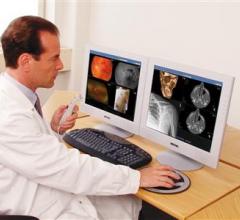If you enjoy this content, please share it with a colleague
RELATED CONTENT
Better management of X-ray radiation doses starts with recording and tracking each exposure patients receive. Dose tracking has come to the forefront of medicine in recent years with the realization that medical imaging has doubled the public’s exposure to ionizing radiation since the 1980s, largely due to the rapid expansion of computed tomography (CT) and minimally invasive procedures guided by angiography.
Radiation dose continues to rise as the number of computed tomography (CT), nuclear, angiography and fluoroscopy examinations grow, leading to a greater risk of patient overexposure to radiation. Healthcare providers must reinforce their efforts to monitor and visualize dose levels from radiology examinations to enhance patient safety and meet new regulatory demands. There also is a need to justify and optimize the usage of radiation dose to find a balance between safer practice, image quality and lower dose — all for the benefit of the patient. Implementing tools for automatic and continuous follow up of radiation dose is at the forefront of meeting these challenges.
Physicians have used radiation in medicine for more than a century. The use of radiation in diagnostic imaging, including computed tomography (CT), fluoroscopy, angiography, mammography, computed radiography (CR) and digital radiography (DR), as well as in nuclear medicine, has aided greatly in the diagnosis and treatment of cancer and other diseases.
The significant increase in radiation exposure and uncertainty regarding the risk of cancer have raised concerns leading to a recent change of direction within medical imaging. Several initiatives to lower dose levels are being established and many healthcare providers have initiated dose reduction programs to guard patient safety and to comply with new regulations.
The radical increase in patient exposure to radiation from medical imaging over the last two decades has created great concerns about its inherent risks. Today, one of the highest priorities on many hospital agendas is to break this trend by achieving improved control of the radiation exposure to their patients.
Sectra is set to showcase several of its workflow efficiency products at the Radiological Society of North America Annual Meeting (RSNA 2013).
Digital breast tomosynthesis (DBT) was approved in the United States for use as a supplement to traditional mammography following U.S. Food and Drug Administration (FDA) review of two studies in which radiologists showed a 7 percent improvement in the ability to distinguish between cancerous and noncancerous cases using 3-D datasets.
BreastScreen Aotearoa, the national breast screening program in New Zealand, is establishing a centralized electronic picture archiving and communications system (PACS) that can store and transmit digital mammography images.
In a new report from Sectra, 78 referring physicians and 78 radiologists share their views on the process of ordering studies and communicating results. Radiology lies at the very center of the healthcare chain. Most patients pass through an imaging department at one point or another in their treatment. That said, an organization’s overall effectiveness is highly dependent upon the ability of radiology to provide excellent service to referring physicians.
Today’s remote viewing systems will stimulate changes and challenges in healthcare in a manner similar to what online banking has done for the financial industry. The areas of improvement include safe, secure, remote access from any browser, or ultimately any mobile device. This is the reality of today, and it comes without the need for special applications or image and associated data downloads from virtually any source.


 February 10, 2014
February 10, 2014 







